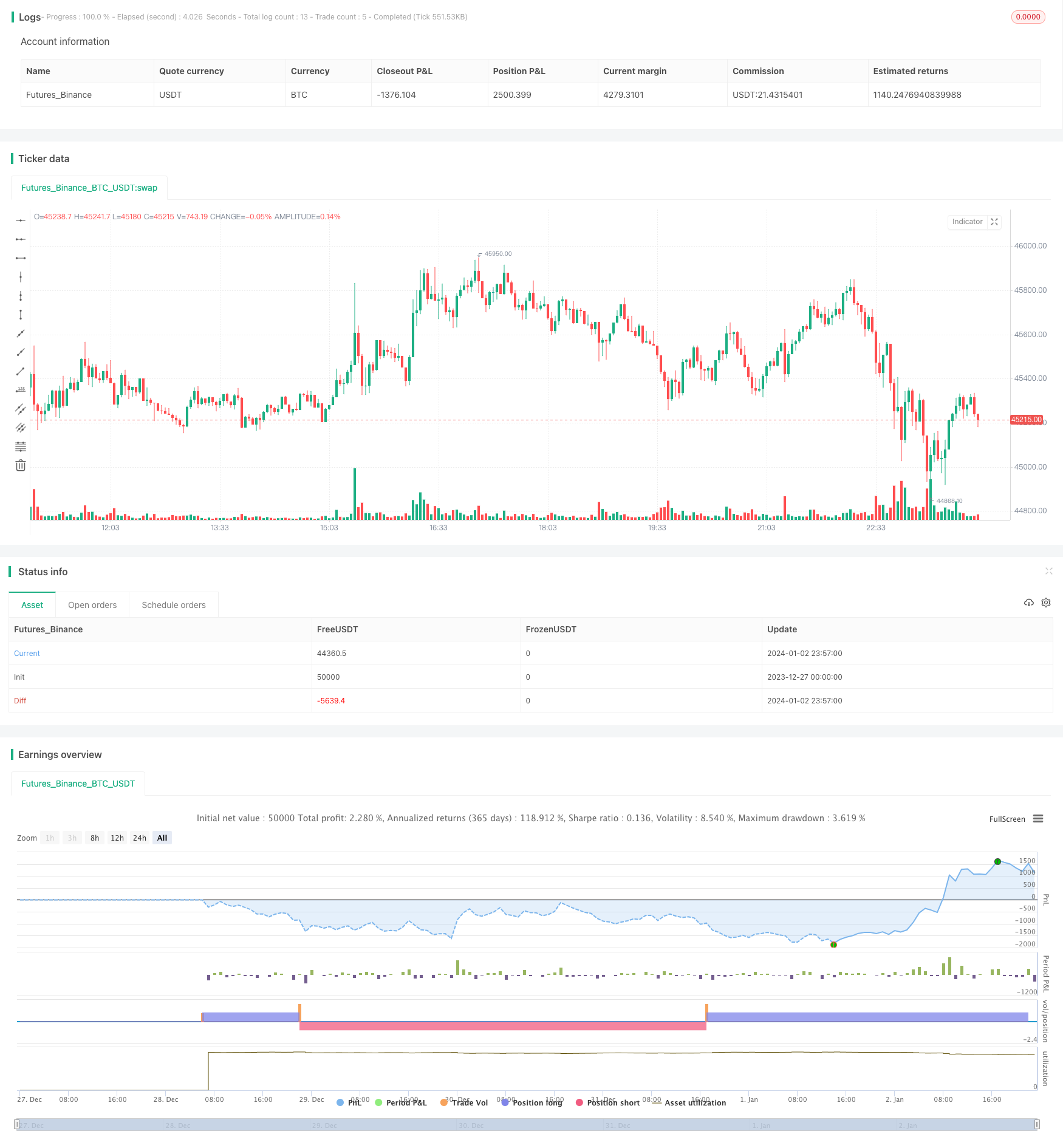
概述
Camarilla支撑阻力层突破策略(Camarilla Pivot Breakout Strategy)是一个利用Camarilla支撑阻力层进行 Entries 和 Exits 的量化交易策略。该策略借鉴传统技术分析中的支撑阻力理论,结合Camarilla数学公式计算不同时间级别的支撑阻力关键点,设定突破这些关键点作为建仓和平仓的条件,达到获取超额收益的目的。
策略原理
该策略的核心逻辑是:计算 Camarilla 公式得到的日线级别的 H4 和 L4 这两个关键支撑阻力点,当价格突破这两个点时产生交易信号。
具体来说,策略首先计算当前K线的日内最高价、最低价以及收盘价的中间值作为当日的支撑阻力中枢点 Pivot。然后计算这三个价格的范围 Range。根据 Range 可以计算出 Camarilla 公式中的各关键支撑阻力位,包括 H4、H3、H2、H1 和 L1、L2、L3、L4 等。其中,H4 为当日的第一阻力位,L4 为当日第一支撑位。
在交易信号产生上,如果当日收盘价突破上方的 H4 位,产生做多信号;如果收盘价突破下方的 L4 位,产生做空信号。这样,通过捕捉关键支撑阻力位的突破,来判断行情的突破方向和力度,产生交易信号。
所以该策略的主要逻辑就是:利用 Camarilla 关键点突破来判断市场结构和获得交易信号。
优势分析
这种利用 Camarilla 支撑阻力位突破的策略有几个主要的优势:
- 利用传统技术分析理论指标,回测稳定
Camarilla 分析依据的是传统技术分析中支撑阻力理论。这种理论测试了时间的考验,可以保证策略在不同品种和不同时间段的稳定性。
- 参数设置简单,容易实盘操作
相比机器学习等定制化策略,Camarilla 策略规则简单,参数少,容易理解和实盘操作。这对于初学者而言是非常重要的。
- 突破信号明确,实现简单
监控 H4 和 L4 的突破就可以建立仓位,策略信号简洁明确,代码实现也很简单。这使得我们可以快速测试策略思路并实盘。
- 可谓是适合高频和低频交易
Camarilla 策略同时适合高频(秒级、分级K线)和低频(日线、周线级)的交易,这是一个很大的优势。
风险分析
当然,这种简单的突破策略也存在一定的风险,主要集中在:
- 可能出现虚假突破的风险
市场突破 Camarilla 点后可能无法继续向同一方向运行,出现反转即虚假突破的风险。这时如果不及时止损,会面临较大的亏损。
- 部分突破无法捕捉的风险
如果只监控收盘价的突破,可能会错过部分突破机会从而影响盈利。这需要通过优化入场条件来解决。
- 盈利可能受限的风险
相比更复杂的策略,仅仅依赖 Camarilla 点突破的盈利空间和幅度可能比较有限。这是可以通过适当调整持仓规模等方法来缓解。
所以这种简单的突破策略还需要进一步通过止损策略、优化入场23168条件、适当调整仓位等方法来控制风险,确保其稳定运行。
优化方向
要进一步优化和改进该 Camarilla 突破策略,可以从以下几个方面入手:
- 结合更多指标判断真假突破
例如结合量能指标、移动均线等来判断突破的可靠性,避免虚假突破的风险。
- 优化突破判定逻辑
比如放宽突破幅度,通过回测确定更佳的参数。或者结合季节性等更多规则。
- 优化止损策略
适当缩小止损幅度,同时防止被套。或者设定错失利润止损、移动止损等策略。
- 动态调整仓位和杠杆
根据市场变化适时调整仓位大小和杠杆参数,让策略更好地适应不同市况。
- 结合更复杂的机器学习算法
运用 LSTM、RNN 等深度学习模型来预测关键点突破概率,让策略更智能化。
总结
Camarilla 支撑阻力层突破策略是一种简单直接、易于实现的量化交易策略。它运用了成熟的技术分析工具,通过捕捉关键支撑阻力点的突破产生交易信号。这种策略优点是稳定、可靠,实盘操作也较为简单。当然,想要获得更高的交易效率,还需要对其进行止损优化、参数调整、风控等进一步优化。
/*backtest
start: 2023-12-27 00:00:00
end: 2024-01-03 00:00:00
period: 5m
basePeriod: 1m
exchanges: [{"eid":"Futures_Binance","currency":"BTC_USDT"}]
*/
//@version=2
//Created by CristianD
strategy(title="CamarillaStrategy", shorttitle="CD_Camarilla_Strategy", overlay=true)
//sd = input(true, title="Show Daily Pivots?")
EMA = ema(close,3)
//Camarilla
pivot = (high + low + close ) / 3.0
range = high - low
h5 = (high/low) * close
h4 = close + (high - low) * 1.1 / 2.0
h3 = close + (high - low) * 1.1 / 4.0
h2 = close + (high - low) * 1.1 / 6.0
h1 = close + (high - low) * 1.1 / 12.0
l1 = close - (high - low) * 1.1 / 12.0
l2 = close - (high - low) * 1.1 / 6.0
l3 = close - (high - low) * 1.1 / 4.0
l4 = close - (high - low) * 1.1 / 2.0
h6 = h5 + 1.168 * (h5 - h4)
l5 = close - (h5 - close)
l6 = close - (h6 - close)
// Daily line breaks
//sopen = request.security(syminfo.tickerid, "D", open [1])
//shigh = request.security(syminfo.tickerid, "D", high [1])
//slow = request.security(syminfo.tickerid, "D", low [1])
//sclose = request.security(syminfo.tickerid, "D", close [1])
//
// Color
//dcolor=sopen != sopen[1] ? na : black
//dcolor1=sopen != sopen[1] ? na : red
//dcolor2=sopen != sopen[1] ? na : green
//Daily Pivots
dtime_pivot = request.security(syminfo.tickerid, 'D', pivot[1])
dtime_h6 = request.security(syminfo.tickerid, 'D', h6[1])
dtime_h5 = request.security(syminfo.tickerid, 'D', h5[1])
dtime_h4 = request.security(syminfo.tickerid, 'D', h4[1])
dtime_h3 = request.security(syminfo.tickerid, 'D', h3[1])
dtime_h2 = request.security(syminfo.tickerid, 'D', h2[1])
dtime_h1 = request.security(syminfo.tickerid, 'D', h1[1])
dtime_l1 = request.security(syminfo.tickerid, 'D', l1[1])
dtime_l2 = request.security(syminfo.tickerid, 'D', l2[1])
dtime_l3 = request.security(syminfo.tickerid, 'D', l3[1])
dtime_l4 = request.security(syminfo.tickerid, 'D', l4[1])
dtime_l5 = request.security(syminfo.tickerid, 'D', l5[1])
dtime_l6 = request.security(syminfo.tickerid, 'D', l6[1])
//offs_daily = 0
//plot(sd and dtime_pivot ? dtime_pivot : na, title="Daily Pivot",color=dcolor, linewidth=2)
//plot(sd and dtime_h6 ? dtime_h6 : na, title="Daily H6", color=dcolor2, linewidth=2)
//plot(sd and dtime_h5 ? dtime_h5 : na, title="Daily H5",color=dcolor2, linewidth=2)
//plot(sd and dtime_h4 ? dtime_h4 : na, title="Daily H4",color=dcolor2, linewidth=2)
//plot(sd and dtime_h3 ? dtime_h3 : na, title="Daily H3",color=dcolor1, linewidth=3)
//plot(sd and dtime_h2 ? dtime_h2 : na, title="Daily H2",color=dcolor2, linewidth=2)
//plot(sd and dtime_h1 ? dtime_h1 : na, title="Daily H1",color=dcolor2, linewidth=2)
//plot(sd and dtime_l1 ? dtime_l1 : na, title="Daily L1",color=dcolor2, linewidth=2)
//plot(sd and dtime_l2 ? dtime_l2 : na, title="Daily L2",color=dcolor2, linewidth=2)
//plot(sd and dtime_l3 ? dtime_l3 : na, title="Daily L3",color=dcolor1, linewidth=3)
//plot(sd and dtime_l4 ? dtime_l4 : na, title="Daily L4",color=dcolor2, linewidth=2)
//plot(sd and dtime_l5 ? dtime_l5 : na, title="Daily L5",color=dcolor2, linewidth=2)
//plot(sd and dtime_l6 ? dtime_l6 : na, title="Daily L6",color=dcolor2, linewidth=2)
longCondition = close >dtime_h4
if (longCondition)
strategy.entry("My Long Entry Id", strategy.long)
shortCondition = close <dtime_l4
if (shortCondition)
strategy.entry("My Short Entry Id", strategy.short)